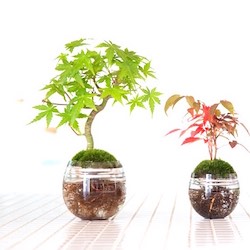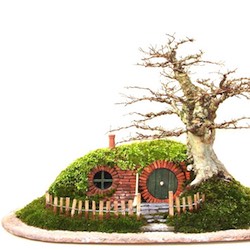Bonsai is a hobby which can be practiced in many different ways and with very different expenditure of money. Even pupils and students with a small allowance can practice this fascinating hobby. Learn how to grow Bonsai trees on a tight budget; low cost bonsai!
My most important advice is: spend your budget cleverly and don't waste it. Consider well what to buy and avoid thoughtless impulse buying. Who wants to have quality Bonsai with little money needs profound knowledge how to create them from cheap or free material.



Cheap nursery plant, the Bonsai 6 years later.
If you are a Bonsai loving beginner, you should invest in knowledge and skills first. Most of all you must invest time! Read the many good websites and forums about Bonsai in the internet and keep doing so regularly for a longer time. If you like to read books, first get informed in the forums which books are recommendable. Unfortunately there are many books with beautiful pictures on the cover but with out-dated or wrong information inside. With a little patience and time you can acquire good books second hand in internet auctions.
Your family or friends could give you a subscription of one of the Bonsai magazines for your birthday or christmas and / or you can buy older issues of the magazines second hand in the internet, where you can often get them at a low price. The detailed articles in these magazines with many explanatory photographs make the complicated Bonsai techniques understandable and applicable.
When you have acquired a certain knowledge in theory and finally want to start in practice, consider well which tree species you like and which of them will be able to thrive under your conditions. Outdoor Bonsai are only a choice if you have a sunny balcony, a terrace or a garden. There are only a few species which will grow nicely in the house all year round. If you acquire a tree species which is not suited for your conditions it will die soon and your money is wasted.
A seminar for recognizing the Bonsai potential of raw material can be a good idea for learning to identify trees that are worthwhile working with. If you fill your garden with dozens of plants without knowing how they can be trained you will have to use all your room, time and money to care for impossible plants which will never become a nice bonsai.
In nurseries, building supplies centers etc. you can often find container plants considerably reduced in price in autumn as the shops don't want to overwinter them. In the gardens of parents, other relatives or friends you might sometimes find old garden plants or young seedlings which won't cost you anything and often are good material. If you discover a desirable tree in other people's gardens, municipal flower beds or in nature then ask the owner for the permission to collect it. Sometimes you will be asked to replace the tree with a young plant or to pay a small sum, but in many cases hardly anything is asked.

Collecting an old juniper from a garden.
If you have acquired some knowledge as well as your first trees, you will now need some tools and materials for working on them. Don't save on the most important tools! A high quality standard shear or twig shear and a good concave cutter should be purchased in any case, so don't buy cheap ones. It is better to buy only two quality tools instead of a cheap set of many tools which are no good and mean wasted money in the end. Unfortunately there are no alternatives to the real Bonsai wire. Anodized aluminum wire, which is easy to use, is available in various price categories and it pays to compare the offers.
For many other tools there are less expensive alternatives which are suitable. Instead of a root hook you can use a hoof pick from a horse-riding outfitter.
The soil scoops made of steel can be substituted by diagonally cut through plastic bottles. Take the disposable chopsticks back home from the Chinese restaurant or Sushi bar as they are great tools for root work and other purposes. A plastic soft drink bottle can be made into a spray bottle or ball shower if you pierce many little holes into the screw cap with a hot needle. Wire cutter, pliers for bending wire and small saws can sometimes be borrowed from your dad's toolbox or purchased for little money in a hardware store. Raffia is available in almost every nursery and you can use your mother's old cheese rotary disc or fondue turntable as a worktable or make one yourself out of wood.
Instead of the expensive Japanese copper or steel watering cans there are cheaper versions made of plastic. The Japanese wound pastes can be replaced by local products, petroleum jelly or for fast growing trees you can use self-adhesive aluminum tape. You don't need to buy Bonsai fertilizer in tiny expensive bottles with beautiful Bonsai pictures on the label, but you can use normal flower fertilizer from the supermarket if you choose one with a well-balanced relation of nitrogen, phosphorous and potassium, as Bonsai should not be fed too much nitrogen. Bonsai soil can be mixed on your own and there are good alternatives for the expensive imported components. Broken foamed clay, pumice, potting compost, lava and clay granulate are some of them.
It has a lot of advantages for every Bonsai enthusiast to join a local Bonsai club. You will not only find help and advice there but you can also borrow tools which you don't possess. Especially when power tools are used it is beneficial to have a person who can teach you how to operate them or who can execute a grinding operation on your tree for you.
Help with a powertool.
An additional convenient side effect of such a community is that trees, young plants, tools and pots are often offered to each other for little money and that the comrades often let their companions benefit from their trader's conditions. Join your club colleagues when they visit important Bonsai shows and look closely at every detail of the exhibition trees, in order to learn. Take every chance to talk with experienced Bonsai people and exchange opinions. This will broaden your horizon!
Local club meeting.
If you have the urgent wish to own a more expensive tree, an important tool or a noble pot, you could ask your family or friends for gift vouchers of your favorite Bonsai trader for your birthday or christmas and accumulate them. Most traders sell the gift vouchers also via online shops.
For trees which are still at the beginning of their Bonsai training you don't need expensive Bonsai pots. Plastic training pots or simple flower bowls (with a drainage hole) which might be found in most homes, are good enough. Later you will want to use at least simple, cheap ceramic pots which can be acquired for very low prices in internet auctions, for example. If you have subtle fingers and like to work with clay, you can start doing pottery yourself. Adult evening classes or a relative or teacher who does pottery and provides a kiln can help and advise you - this is a good start. If you do well, your trees might soon be planted in individually handmade unique pots which would not be affordable otherwise.Guide: find a Bonsai club near you!
Bonsai raw material in a plastic Bonsai pot.
After a few years, when you are advanced in the techniques and care of Bonsai and you have collected a larger number of trees, it can often be a good idea, to sell some trees from your early days (there is always a buyer who will want them if the price is fair) and use the total revenue for getting one better tree or raw material. This strategy can improve the level of your collection step by step.
If you have enough time and space it is a good idea to propagate Bonsai tree species additionally. Seedlings and cuttings of popular Bonsai species are much fun and a valuable experience, although it takes quite a long time. In most cases you can collect seeds and cuttings without having to pay for them, if you look in gardens, parks or arboretums in autumn or if you ask your local club colleagues if you can have the cut off twigs of their satsuki azalea Bonsai when they prune them.
Young satsuki azaleas grown from cuttings.
Especially the lovely flowering satsuki azaleas are sought-after and you can always sell surplus specimen for a good price, if they are strong and of popular varieties. This can help to satisfy some other wish.
You see, there are many possibilities to make Bonsai also with little money. The most important thing is: don't get discouraged and never give up. Believe that you will be able to create great Bonsai one day and pursue the goal, even if you don't know exactly today how you can reach it. You will learn a great lot on the way, meet many wonderful people and experience that undreamed-of possibilities can occur.
Written by: Heike van Gunst. "Heike van Gunst (from Hamburg, Germany) has been growing Bonsai for more than 30 years. She has gained manifold skills in training and caring for diverse species and has developed a passion for Bonsai pots and Bonsai display. Writing and translating Bonsai articles and Bonsai book translations are her special subject.". Please visit her Bonsai website for more information!








